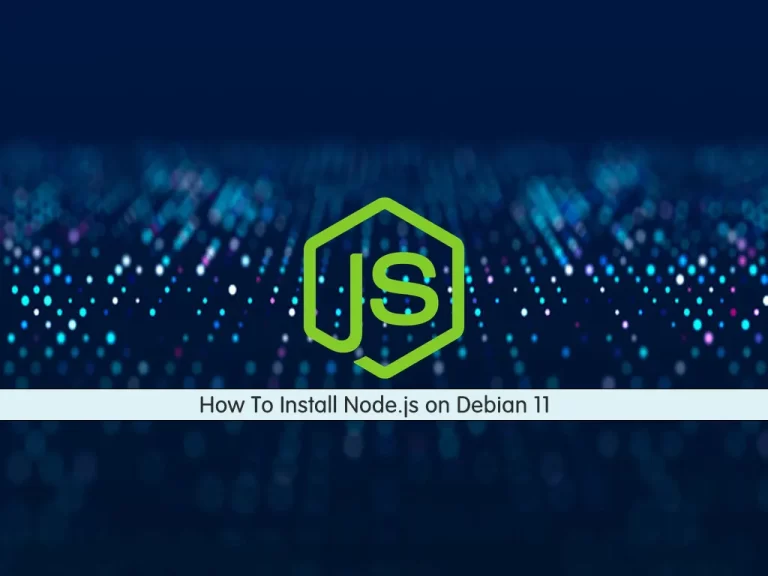Share your love
How To Install Node.js on Debian 11

In this article, we want to teach you How To Install Node.js on Debian 11.
Node.js is a free and open-source server environment. It runs on different platforms like Windows, Linux, Unix, Mac OS X, etc. It can generate dynamic page content. Also, Node.js can create, open, read, write, delete, and close files on the server. and it can add, delete, and modify data in your database.
How To Install Node.js on Debian 11
In this article, we show you install Node.js on Debian 11 in different ways:
- Install Node.js from the default Debian repository.
- Use the PPA repository.
- Use NVM (Node Version Manager) to install and activate different versions of Node.
Then we will show you how to remove Node.js from your server.
You need to log in to your server as a non-root user with sudo privileges. To do this you can check our article about the Initial server setup with Debian 11.
Install Node.js from the default Debian repository
To get Node.js from the default Debian repository, you can use the APT package manager.
First, update your local package index with the following command:
sudo apt update
Then, install the Node.js package, and the NPM, Node Package Manager, with the following command:
sudo apt install nodejs npm
You can verify that your installation was successful by checking the Node.js version with the following command:
node -v
In your output you will see:
Output
v12.22.5Install Node from the PPA repository
You can install Node.js from a PPA (personal package archive) maintained by NodeSource.
NodeSource has PPAs available for Node versions from 0.10 through to 12.
Use curl to get the installation script for your preferred Node.js version. Remember to replace the 12.x with your preferred version:
curl -sL https://deb.nodesource.com/setup_12.x -o nodesource_setup.shThen run the installation script with the following command:
sudo bash nodesource_setup.sh
The PPA will be added to your configuration and your local package cache will be updated automatically. Now you can install the Node.js package on Debian 11 in the same way you did in the previous step:
sudo apt install nodejs
You can verify the installation with the following command:
Output
v12.22.5At this point, you don’t need to install a separate package for NPM.
NPM uses a configuration file in your home directory to keep track of updates. It will be created the first time you run npm.
Use the following command to verify that npm is installed and create the configuration file:
npm -v
If you want to have the necessary tools to work with npm packages that require compiling code from source, you can use the following command:
sudo apt install build-essential
Install Node.js with NVM
You can download the NVM installation script from the Project’s GitHub Page, with the curl tool.
Note that the version number may differ from what is here in this command:
curl -sL https://raw.githubusercontent.com/nvm-sh/nvm/v0.39.0/install.sh -o install_nvm.shThen run the NVM installation script with the following command:
bash install_nvm.sh
You don’t need sudo here because nvm is not installed into any privileged system directories. To get access to the NVM functionality, you need to source the ~/.profile file so that your current session knows about the changes:
source ~/.profile
To list the available Node.js versions on Debian 11 run the following command:
nvm ls-remote
In your output you will see:
Output ... v14.18.1 (Latest LTS: Fermium) v15.0.0 v15.0.1 v15.1.0 v15.2.0 v15.2.1 v15.3.0 v15.4.0 v15.5.0 v15.5.1 v15.6.0 v15.7.0 v15.8.0 v15.9.0 v15.10.0 v15.11.0 v15.12.0 v15.13.0 v15.14.0 v16.0.0 v16.1.0 v16.2.0 v16.3.0 v16.4.0 v16.4.1 v16.4.2 v16.5.0 v16.6.0 v16.6.1 v16.6.2 v16.7.0 v16.8.0 v16.9.0 v16.9.1 v16.10.0 v16.11.0 v16.11.1
As you can see the current LTS version is v14.18.1. you can install it with the following command:
nvm install 14.18.1You can verify the Node.js installation on Debian 11 with the following command:
node -v
Your output should similar to this:
Output
v14.18.1You can check what version of Node.js is installed on Debian 11 with the following command:
nvm ls
If you want to use each of them in default you can use the following command:
nvm alias default 14.18.1You can also reference it by the alias like this:
nvm use default
Let’s see how to remove Node.js on Debian 11.
Remove Node.js on Debian 11
To remove Node.js versions installed from the default Debian repository or from the PPA, you can use the following command:
sudo apt remove nodejs
This command will remove the package and the configuration files.
To remove a version of Node.js that you have enabled with NVM, first, you need to check the currently active version with the following command:
nvm current
If the version you want to remove is the currently active version, first, you must deactivate the nvm to enable your changes:
nvm deactivate
Then, you can remove it with the following command:
nvm uninstall node_versionIf the version you are targeting is not the current active version, you just can use the above command to remove it.
Conclusion
At this point, you learn to install Node with different versions on your Debian 11 server. Also, you can easily remove it from your server.
Hope you enjoy this article about How To Install Node.js on Debian 11.



